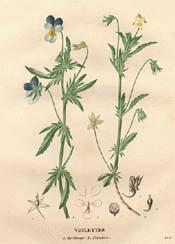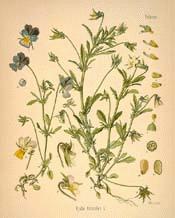
Botanical.com Home Page
HeartseaseBotanical: Viola tricolor (LINN.)
---Synonyms---Wild Pansy. Love-Lies-Bleeding. Love-in-Idleness. Live-in-Idleness. Loving Idol. Love Idol. Cull Me. Cuddle Me. Call-me-to-you. Jackjump-up-and-kiss-me. Meet-me-in-the-Entry. Kiss-her-in-the-Buttery. Three-Faces-under-a-Hood. Kit-run-in-the-Fields. Pink-o'-the-Eye. Kit-run-about. Godfathers and Godmothers. Stepmother. Herb Trinitatis. Herb Constancy. Pink-eyed-John. Bouncing Bet. Flower o'luce. Bird's Eye. Bullweed.
|

|
(Viola tricolor LINN.) Click on graphic for larger image |
The flowers (1/4 to 1 1/4 inch across) vary a great deal in colour and size, but are either purple, yellow or white, and most commonly there is a combination of all these colours in each blossom. The upper petals are generally most showy in colour and purple in tint, while the lowest and broadest petal is usually a more or less deep tint of yellow. The base of the lowest petal is elongated into a spur, as in the Violet.
The flowers are in due course succeeded by the little capsules of seeds, which when ripe, open by three valves. Though a near relative of the Violet, it does not produce any of the curious bud-like flowers - cleistogamous flowers - characteristic of the Violet, as its ordinary showy flowers manage to come to fruition so that there is no necessity for any others. Darwin found that the humble bee was the commonest insect visitor of the Heartsease, though the moth Pluvia visited it largely - another observer mentions Thrips small wingless insects - as frequent visitors to the flowers. Darwin considered that the cultivated Pansy rarely set seed if there were no insect visitors, but that the little Field Pansy can certainly fertilize itself if necessary.
The flower protects itself from rain and dew by drooping its head both at night and in wet weather, and thus the back of the flower and not its face receives the moisture.
The wild species is an annual, but from it the countless varieties of the perennial garden pansies, with blossoms of large size and singular beauty, are supposed to have originated. It is a very widely distributed plant, found not only throughout Britain, but in such diverse places as Arctic Europe, North Africa, Siberia and N.W. India. Several of the varieties have been distinguished as subspecies: the most marked of these are V. arvensis, most common in cornfields, with white or yellowish flowers, with spreading petals; and lutea, which has a branched rootstock, short stems, with underground runners, and blue, purple or yellow flowers with spreading petals much longer than the sepals.
Miss Martineau tells us that many kinds are common in meadows in America, and says that as early as February the fields about Washington are quite gay with their flowers.
The Pansy is one of the oldest favourites in the English garden and the affection for it is shown in the many names that were given it. The Anglo-Saxon name was Banwort or Bonewort.
Miss Rohde is of opinion that Banwort was the old name for the daisy.
She says: 'It would be interesting to know if the daisy is still called banwurt in the north,' and she quotes from Turner's Herbal in support of this, 'The Northern men call thys herbe banwurt because it helpeth bones to knyt againe....'
Its common name of Pansy (older form 'Pawnce,' as in Spenser) is derived from the French pensées, the name which is still used in France.
'Love in Idleness' is still in use in Warwickshire. In ancient days the plant was much used for its potency in love charms, hence perhaps its name of Heartsease. It is this flower that plays such an important part as a love-charm in the Midsummer Night's Dream.
The celebrated Quesnay, founder of the 'Economists,' physician to Louis XV, was called by the king his 'thinker,' and given, as an armorial bearing, three pansy flowers.
In many old Herbals the plant is called Herba Trinitatis, being dedicated by old writers to the Trinity, because it has in each flower three colours.
Stepmother is a familiar name for it in both France and Germany, from a fanciful reference to the different-shaped petals, supposed to represent a stepmother, her own daughters and her stepchildren.
[Top]
---Part Used Medicinally and Preparation for Market---The whole herb, collected in the wild state and dried.
The Wild Pansy may be collected any time from June to August, when the foliage is in the best condition.
---Constituents---The herb contains an active chemical principle, Violine (a substance similar to Emetin, having an emeto-cathartic action), mucilage, resin, sugar, salicylic acid and a bitter principle. When bruised, the plant, and especially the root, smells like peach kernels or prussic acid. The seeds are considered to have the same therapeutic activity as the leaves and flowers.
---Medicinal Action and Uses---The Pansy has very similar properties to the Violet.
It was formerly in much repute as a remedy for epilepsy, asthma and numerous other complaints, and the flowers were considered cordial and good in diseases of the heart, from which may have arisen its popular name of Heartsease as much as from belief in it as a love potion.
- Gerard states:
- 'It is good as the later physicians write for such as are sick of ague, especially children and infants, whose convulsions and fits of the falling sickness it is thought to cure. It is commended against inflammation of the lungs and chest, and against scabs and itchings of the whole body and healeth ulcers.'
It was formerly official in the United States Pharmacopoeia, and is still employed in America in the form of an ointment and poultice in eczema and other skin troubles, and internally for bronchitis.
Some years ago attention was called to this herb by a writer in the Medical Journal as a valuable remedy for the cutaneous disorder called crusta lactes, or Scald head, in children. For this purpose, 1/2 drachm of dried leaves, or a handful of the fresh herb boiled in milk, was recommended to be given every morning and evening: poultices formed of the leaves were likewise applied with success. By several medical writers its use is said to have proved very efficacious in this complaint.
On the Continent, the herbaceous parts of the plant have been employed for their mucilaginous, demulcent and expectorant properties. The root and seeds are also emetic and purgative, which properties as well as the expectorant action of the plant are doubtless due to the presence of the violine.
Pansy leaves are used on the Continent in place of litmus in acid and alkali tests.
|
Purchase from Richters Seeds
Heartsease (Viola tricolor) Seeds |
© Copyright Protected 1995-2025 Botanical.com
